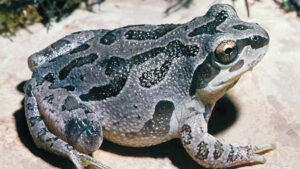In search of the Illinois chorus frog

By CARLA RICH MONTEZ
In the sandy wetlands of the Illinois River Watershed, a race is underway beyond our view. Scientists of the U.S. Fish and Wildlife Service and Illinois Department of Natural Resources are working in earnest to observe and document the Illinois chorus frog, a tiny one- to-one and a half-inch amphibian that once thrived throughout the floodplain, but which is now a threatened species in Illinois.
Why are there so few of these small frogs? Part of the answer lies in how little is known about Illinois chorus frogs. What we do know is that these reclusive animals spend nearly 85 percent of their lives in underground burrows. Once a frog emerges, it’s above ground for only a month or so, and then it disappears. Such secretive behavior leaves many questions unanswered, and this lack of knowledge only hampers conservation efforts.
HABITAT
Not only are Illinois chorus frogs elusive, they also need very specialized habitat conditions to thrive. In order to reproduce, they depend on temporary ponds, flooded fields, and ditches that collect during the spring rains. If these ephemeral wetlands and ditches dry up too soon, the offspring may not finish their lifecycle. As you can imagine, this limitation also impacts their overall population.
Illinois chorus frogs also prefer sandy floodplain soils that are great for burrowing. Unfortunately, seasonal floods may carry dirt and debris into these habitats, thereby hampering any digging. Despite their muscular, Popeye-like front arms, these mighty amphibians can’t burrow in soil with high percentages of loam or tangled organic matter. It’s just too thick!
SENSITIVE TO ENVIRONMENTAL CHANGES
Even though they are tough and can live in both water and on the land, Illinois chorus frogs are sensitive to the world around them. While this habitat diversity affords them some protection, it also makes them susceptible to even the slightest changes in the environment, thus their status as an indicator species. They are canaries in the coal mine, so to speak. Changes in weather patterns, pollution, land development, wetland drainage and leveling, as well as other habitat pressures further challenge their population numbers.
Altogether, these circumstances have handicapped efforts to develop a complete profile of the Illinois chorus frog and explain why a race is in progress to learn more about this mysterious amphibian.
You can join the race to help the Illinois chorus frog. By protecting the land and water that they depend on each spring, you can create a frog-friendly environment that will help them recover.



Leave a Reply